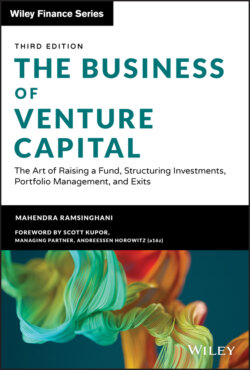Читать книгу The Business of Venture Capital - Mahendra Ramsinghani - Страница 35
From Entrepreneur to VC
ОглавлениеThe recent wave of investors has come from a demonstrated entrepreneurial background. Having started a company, raised capital, and generated an exit eminently qualifies you to serve other entrepreneurs well. But that does not guarantee success as an investor.
Exhibit 4.1 illustrates the pros and cons of each pathway.
Exhibit 4.1 Entry Points in Venture Capital.
| Pathway | Opportunities | Challenges |
|---|---|---|
| Entrepreneurial/ startups | Engage with entrepreneurs. Ability to understand value drivers, technology challenges, and team dynamics. | Shifting from player to coach — managing temptation to jump in and drive when companies underperform. Sector expertise can be narrow. Pace can be too slow. As one entrepreneur-turned-VC remarked, “As a CEO, I was used to six emergencies before 9 a.m. As a VC, I am getting so bored and lazy.” |
| Investment banking/consulting | Wider horizon of sector knowledge and exposure to opportunities | Lack of founder network/awareness of investment dynamics/risk-taking abilities |
| Corporate VC/ micro VCs/angel networks | Develop investment experience, sharpen due diligence abilities, and establish track record of investments | Differing agendas and conflicts. Investment activities may be limited by corporate agenda or angel interests. Speed of decision-making can be a concern. |
| Institutional investors | Ability to understand the LP/investor perspectives. Build relationships and have knowledge of new funds. Ability to time the entry. | Risk of being perceived as an asset manager versus an investor. Number of investments may be limited. Process is often slow and involves buy-in from various stakeholders. |
| Service providers | Ability to function as a resource to entrepreneurs. | Lack of domain expertise, lack of deeper understanding of financial dynamics. |
When Jan Garfinkle, founder of Arboretum Ventures Fund, decided to be a venture capitalist, she polished her resume and approached several early-stage venture funds. But every fund turned her down. So she decided to start her own fund.
Jan had spent two decades cutting her teeth at two venture-backed cardiovascular device companies. A large publicly traded company acquired both these companies, leaving Jan a bit richer, wiser, and hungrier. She started off as a product manager with Advanced Cardiovascular Systems (ACS), a forerunner in over-the-wire angioplasty — a technique that reopens narrowed or blocked arteries in the heart (coronary arteries) without major surgery. The founder of the company, John Simpson, once remarked, “When we started the company, there was no interventional cardiology device sector.”18 C. Richard (“Dick”) Kramlich, founder of NEA, had then invested in Advanced Cardiovascular Systems. Dick once said of ACS, “The procedure was entirely noninvasive … the body didn't have to go through the trauma it once had to endure.”19 At Advanced Cardiovascular Systems, Jan spent six years in marketing and sales of angioplasty systems. When Eli Lilly came knocking and acquired the company, the foundation stone for Guidant Corporation was laid. “We were the largest single shareholder in Advanced Cardiovascular Systems… . The company did extremely well,”20 Kramlich would say. That was over 25 years ago, when Jan was at the threshold of her career. To be in an NEA-backed startup was certainly fortuitous for Jan's career path.21
Like all good serial entrepreneurs, Jan moved on to John Simpson's next company, Devices for Vascular Intervention. The same founder who had built Advanced Cardiovascular Systems was now leading the charge in the next wave of the cardiovascular sector. Devices for Vascular Intervention laid its bets on atherectomy — a procedure to remove plaque from arteries. Here, Jan wrote the first business plan, and over the next six years, as director of marketing and clinical research, she dove deeply into the universe of regulatory trials and approvals. Again, Eli Lilly had been watching closely and came knocking at the door. These two companies acquired by Eli Lilly became the foundation for Guidant Corporation, which was eventually spun off by Eli Lilly as a separate company and listed as GDT on the New York Stock Exchange (NYSE). Boston Scientific acquired Guidant in 2006 for $27.2 billion. At that time, the vascular intervention business was valued at $4.1 billion.22
When venture firms turned her down time and again, Jan decided to do what any entrepreneur does — never take no for an answer! She decided to raise her own fund and launched Arboretum Ventures, a fund focused on early-stage health care and medical device companies. Having lived close to Nichols Arboretum in Ann Arbor, and with her own DNA of a nurturing type, she found the name to be the appropriate encapsulation of her philosophies and style.
Like Jan, John Hummer, cofounder of Hummer-Winblad, interviewed at five venture firms. “All five turned me down — on the same day,” reminisces John with a smug smile. John went on to start his own fund. “I climbed in from the window, as most do to get in this business of venture capital,” comments the towering John, who once was a professional basketball player.
Most venture professionals agree that there is no straight path into the business of venture capital. You have to climb in from the window, if that's what it takes! Jan and John were able to raise their own funds: for others, the starting point is often at an entry-level position.
